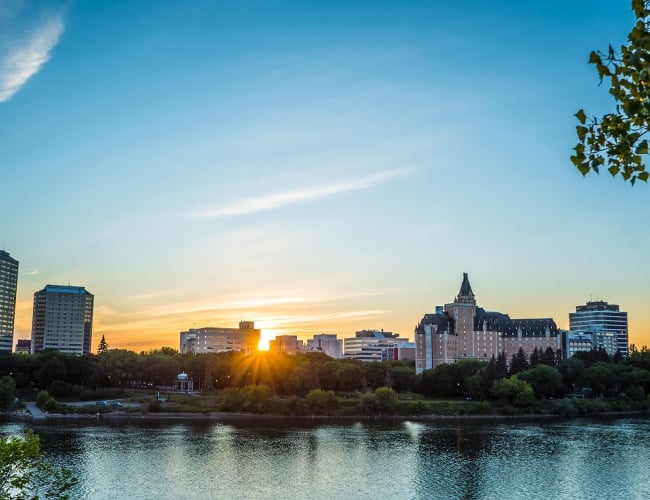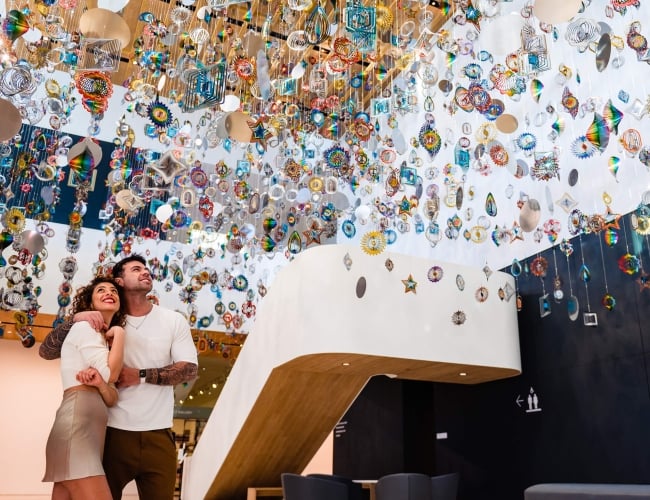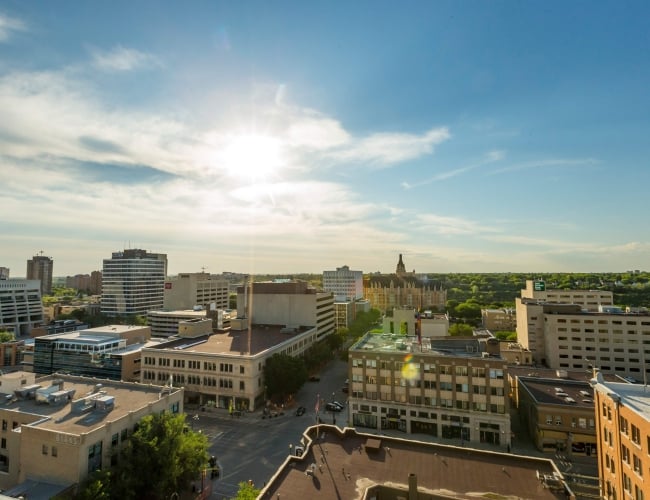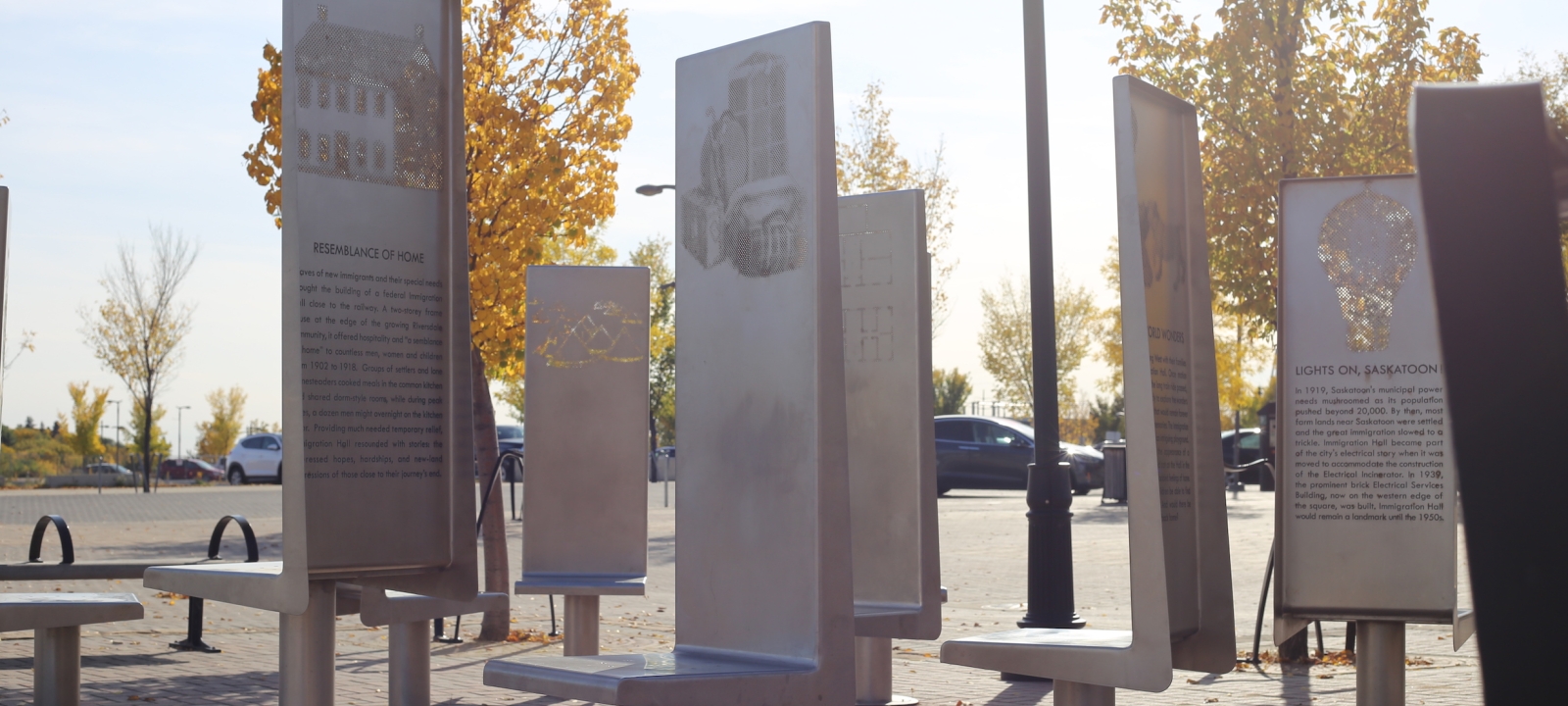
Powerful Public Art in Riversdale
Saskatoon is FULL of public art - some new, some old, some permanent and some temporary. Public art brightens up the city, facilitates important conversations and allows the public to freely engage with new ideas and art forms. Join me on a brief journey through Riversdale as I share photos and details about a few public art pieces that recently caught my attention.

But first - a little background on the neighbourhood! Riversdale is one of Saskatoon’s oldest neighbourhoods and was one of the three original settlements that first formed the city of Saskatoon in 1906*. The area of Riversdale is full of diversity, character and history and it continues to grow into one of Saskatoon’s most frequently visited areas for shopping, restaurants, and leisure. The unique combination of honouring the past while looking to the future is mimicked in the public art throughout Riversdale. Not only is Riversdale full of public art, but there are numerous places to stop for a drink or snack while you explore the neighbourhood, including: 9 Mile Legacy Brewing, Drift Sidewalk Cafe & Vista Lounge, Odd Couple, and Primal.
As I made my way into Riversdale by walking underneath the newly renovated Sid Buckwold Bridge, I noticed a cougar out of the corner of my eye. Luckily the cougar was made of steel and while it may look menacing, artist Kevin Quinlan intends for it to encourage viewers “to keep thinking about living in harmony with the wildlife in and around the City”.

Perhaps you may be able to spot a few wild animals while you wander along the edge of the neighbourhood on The Meewasin Trail. This cougar artwork also reminded me to be more aware of my surroundings - I could have easily been looking at my phone and missed seeing this striking piece. I thanked Saskatoon Cougar for reminding me to be cognizant of what’s around me and I continued into the Riversdale neighbourhood.
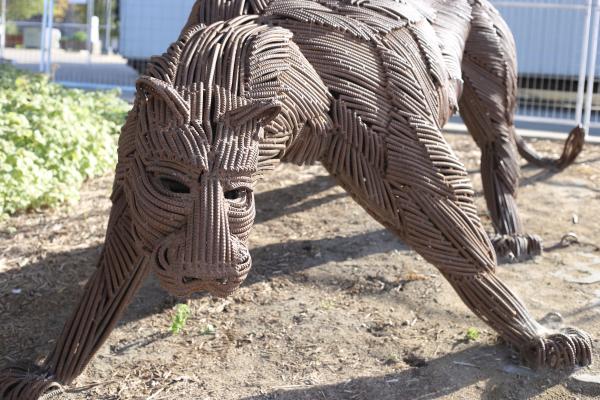
I turned to walk toward the South Saskatchewan River and noticed The Storytelling Chairs shining in the sun as I entered Market Square. I have walked past these stainless steel seats many times before and have often wondered about their meaning but I admit, I have never taken much time to engage with the art piece.

I’m glad I finally decided to take a closer look at The Storytelling Chairs as I was able to learn more about the history of this specific area of the city. The back of each seat tells the story of Immigration Hall. Saskatoon’s Immigration Hall was built in 1901 and offered a “semblance of home” to new immigrants as they arrived in the area between 1902-1918. The dorm-style rooms and common kitchen provided hospitality and space for newcomers to adjust to life in Canada and share stories with one another about their journeys.
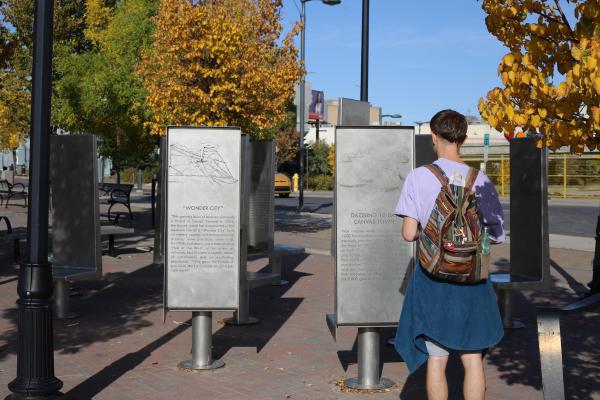
Immigration Hall was located where The Storytelling Chairs are now located. These chairs encourage the public to sit down and gather for conversations. They are even spaced far enough apart for you to have engaging, physically distanced conversations with familiar or unfamiliar faces. This installation was designed by Jyhling Lee and Paul Koopman. These two artists also created Prairie Wind, the towering artwork that is found inside the roundabout in front of Remai Modern.
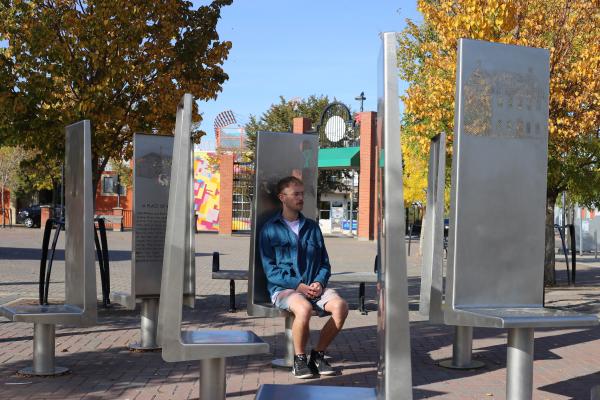
After resting in The Storytelling Chairs and thinking about the journey of immigrants to this land, I began to walk toward one of my favourite works in the city. Looking out toward the river, I listened closely to the wind and birds and I could soon hear the familiar song of the chimes from one of the newest permanent public art pieces in Saskatoon: The Coming Spring by Gordon Reeve. The artwork was commissioned by the Saskatoon Tribal Council and the City of Saskatoon in response to the Truth and Reconciliation Commision of Canada’s Calls to Action (see the city’s Public Art webpage for more information about the piece and other public art in Saskatoon)
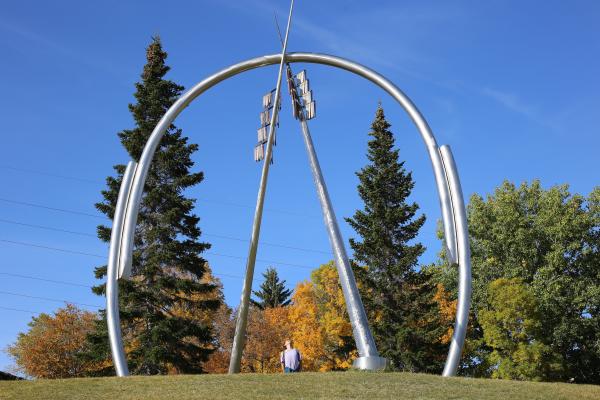
The massive structure recognizes the legacy of Indigenous people and was installed at the top of the hill in Reconciliation Circle (within Victoria Park) in the spring of 2018. The artist intends for this piece to honour the history of First Nations and Métis people in this region and also supports storytelling, as stated on a plaque in front of the artwork: “May all who come to this place remember their own stories and be free to tell them”.
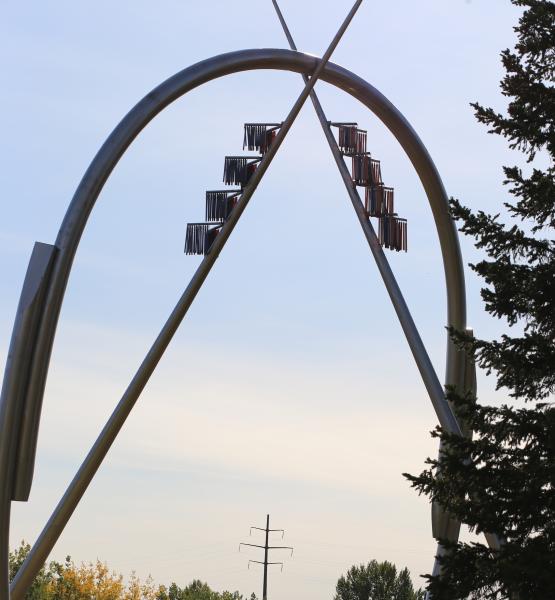
The longer 47-foot spire pointing North represents the First Nations’ long history and includes a steel band with feather cut-outs, whereas the shorter 39 foot spire pointing South represents the history of the Métis people and includes a band with infinity symbol cut-outs - the same symbol found on the Métis flag.
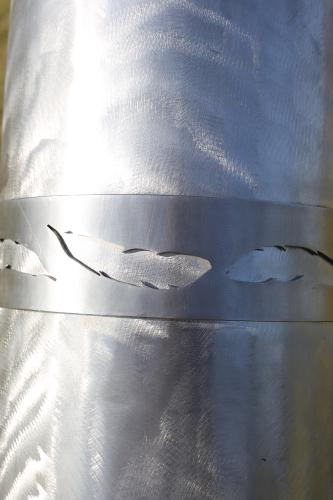
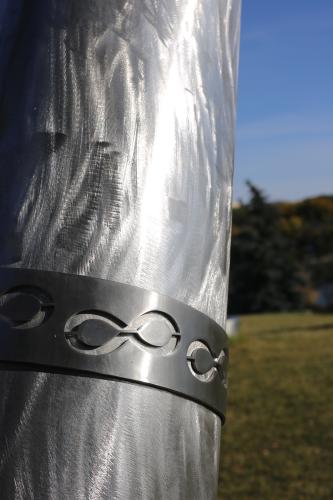
Just like how The Storytelling Chairs can facilitate conversations that build empathy for the struggles immigrants faced when coming to Saskatoon in the early 1900s, The Coming Spring also encourages conversations and contemplation. Conversations may simply be about how tall the structure is or about how the light from the sun and moon dances along the stainless steel spires - but perhaps viewing The Coming Spring may also lead to deeper thoughts about the symbolic meaning of the chimes and the ongoing effects of the residential school system. As noted on the City’s website: “Suspended high on each spire are moving chimes. The rustling and bell-like sounds the chimes make suggest the voices of children heard at a distance, representing the children taken by the residential system from all of the communities in Treaty Six Territory.”
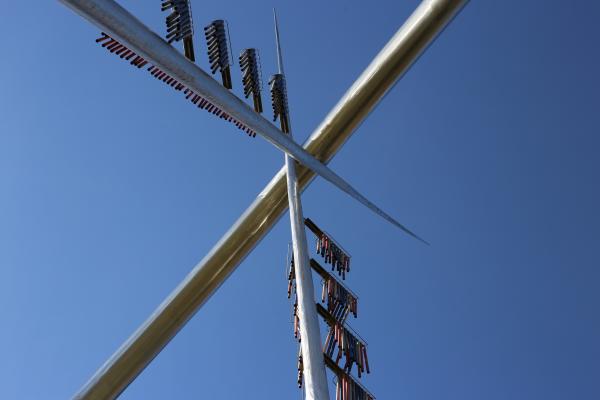
Public art pieces like The Coming Spring and The Storytelling Chairs remind us of the diverse history of this city. The land along the river is powerful, and the placement of The Coming Spring and The Storytelling Chairs provide opportunities for the public to reflect on the history of this land. Pieces like these also remind us of the consistent and open conversations that are necessary to ensure reconciliation & understanding one another is not limited to naming a park or installing artwork.
After taking some time to reflect beneath the sound of the chimes and to engage a bit more with the design of the piece, I knew I wanted to head closer to 20th street to check out some of the murals that are popping up around the neighbourhood.
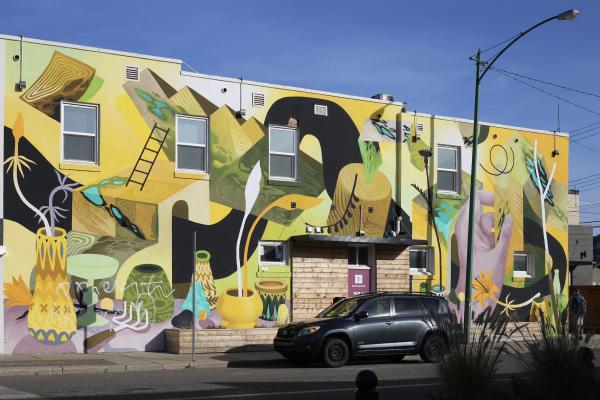
In the past few years, Riversdale has gotten even more colorful and its walls are full of murals by both established and emerging artists - it seems like new murals appear every month. These murals allow the public to experience art on a massive scale and they are generally easy to spot while you travel through the neighbourhood. A few of my favourites include the bright yellow Jill Stanton mural on Rock and Bloom (southeast corner of Ave D and 20th Street) the surreal mural by Kris Moffatt found on the side of OutSaskatoon (213 Ave C) and the colourful, swirly design that takes up the entire outside of new Riversdale interior design shop Alt Haus (226C Ave C South).
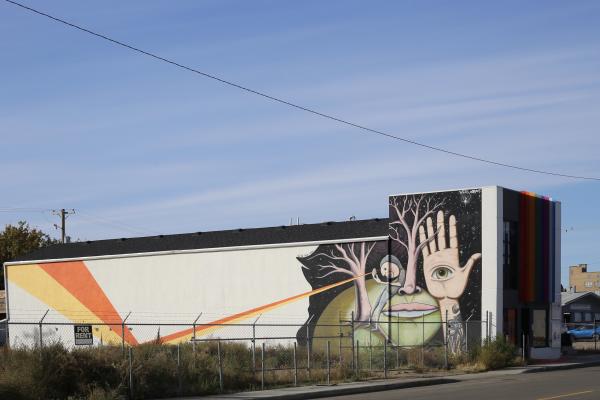
Expect to see more and more businesses adding murals to their walls, as one of Alt Haus’s two owners is muralist Jo Van and they seem to be quite busy with mural projects around the city.

Just recently, the 2020 Placemaker Projects have been installed around Saskatoon and one of the three structures on view happens to be located in the Riversdale BID at 602 20th St West: “Saadat Qalbi/Miyawâtam 2”. The Placemaker Projects are temporary art pieces that invite the public to engage with contemporary art practices. As noted on the public art page of the City’s website: “The pieces by Ruth Cuthand and Suada Jailan, curated by Dr. Jen Budney, consists of three hand-painted aluminum sculptures composed of floral motives inspired by both Cree/Michif beadwork and traditional East African henna design. The title, “Saadat Qalbi/Miyawâtam” translates to “Happiness of the heart/They are joyful or fun-loving.” The inclusion of the bright colours and the cross-cultural philosophy of this work is a perfect match for Riversdale’s diverse history and creative eye to the future.

There is so much public art to experience in Saskatoon. Be sure to keep your eyes peeled while you explore the city since new pieces are being installed all the time!
All photos by Kristen Boyé
